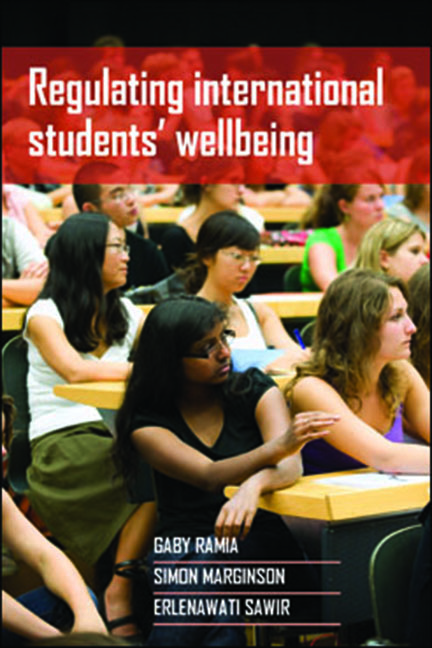Book contents
- Frontmatter
- Contents
- List of figures and tables
- Acknowledgements
- Preface
- one Introduction: global students and their discontents
- two Governing globalisation? National regulation and international student wellbeing
- three Fast growing, diverse: mapping the business of international education
- four ‘There’s gold in them thar students!’ Australia and New Zealand in the global market
- five Much regulation, minimal protection: the Australian model
- six Pastoral care, minimal information: the New Zealand model
- seven Different frameworks, similar outcomes: comparing Australia and New Zealand
- eight Doing it differently: national and global re-regulation and trans-national student citizens
- nine Conclusion
- References
- Index
four - ‘There’s gold in them thar students!’ Australia and New Zealand in the global market
Published online by Cambridge University Press: 03 February 2022
- Frontmatter
- Contents
- List of figures and tables
- Acknowledgements
- Preface
- one Introduction: global students and their discontents
- two Governing globalisation? National regulation and international student wellbeing
- three Fast growing, diverse: mapping the business of international education
- four ‘There’s gold in them thar students!’ Australia and New Zealand in the global market
- five Much regulation, minimal protection: the Australian model
- six Pastoral care, minimal information: the New Zealand model
- seven Different frameworks, similar outcomes: comparing Australia and New Zealand
- eight Doing it differently: national and global re-regulation and trans-national student citizens
- nine Conclusion
- References
- Index
Summary
Introduction
In the period between 2000 and 2010, among the developed nations of the OECD, Australia and New Zealand (and particularly the latter) increased their global market share sharply. Inward student mobility into these two European heritage nations on the border of Asia increased more rapidly than in other OECD nations. This was not only because of a relatively favourable location next to the fast moving zones of economic development in East and Southeast Asia. For most of the 1990s and 2000s the Australian and New Zealand governments encouraged the rapid growth of international education as a source of revenue and of human capital via the inward migration of graduates, although Australia took a different approach in 2009-11 (as did the UK at the same time). Growth was continuous in Australia until 2010, and while, as discussed later in Chapter Six, there were fluctuations in New Zealand, as enrolments from East Asia rose and fell, the longer-term pattern has been one of significant growth. On their side, education institutions in Australia and New Zealand have had strong economic incentives to increase international student numbers. Formal regulation has mostly encouraged the export sectors to drive their own activity and growth. The characteristics and the significance of this are central themes within the remaining chapters of this book.
This chapter provides an overview discussion of the evolution of market share in Australia and New Zealand. It also discusses the problems and prospects of cross-border education in the two countries as at the time of writing. The chapter provides the political economy backdrop for the detailed discussion of regulation in the two nations that follows in Chapters Five and Six.
Export sector in Australia
Prior to the 1985 Australian legislation that established the international education market, the main focus of international education was aid-based and designed to assist the processes of modernisation and development in Asian nations. The underlying strategic objective of the Colombo Plan, launched in 1951, was to steer post-colonial nations in Asia away from communism by shaping the outlook of their future leaders. But there were also unplanned effects in Australia itself. The Colombo Plan students participated in Australian higher education at a time when the White Australia policy was still in force and played a crucial part in breaking it down.
- Type
- Chapter
- Information
- Regulating International Students’ Wellbeing , pp. 59 - 76Publisher: Bristol University PressPrint publication year: 2013



